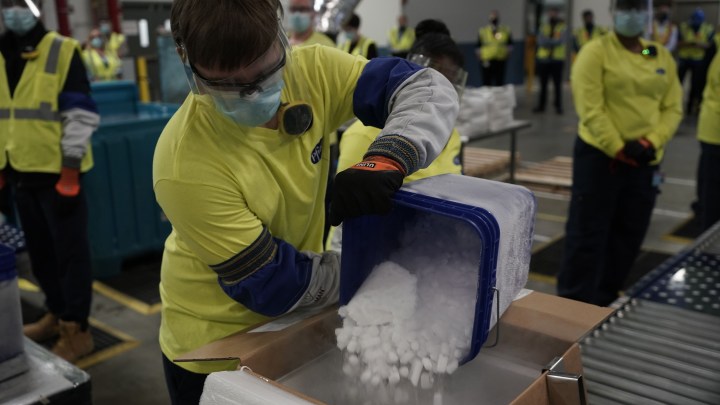
As ultra-cold Pfizer vaccines ship out, dry ice supplies tighten in Northeast
As ultra-cold Pfizer vaccines ship out, dry ice supplies tighten in Northeast

Supplies of dry ice, critical to the transport of the Pfizer COVID-19 vaccine, which has to be kept at a minimum of -76 Fahrenheit, are showing signs of tightening in the New England region, a key industry analyst said.
“I’m told it’s very tight,” Sam Rushing, industry consultant at Advanced Cryogenics Limited, said. “Businesses say they are receiving product and it’s gone in a matter of hours instead of a day or two.”
In Cambridge, Massachusetts, Acme Ice is fielding orders like never before from hospitals preparing to vaccinate the public, Boston 25 News reported this week. But it’s not clear vaccine delivery demand is causing the scarcity in the Northeast, Rushing said.
Dry ice is made from carbon dioxide, normally something society doesn’t want because it warms the planet. But in this case, bring on the CO2.
One of the main sources for CO2 is the industrial process of making ethanol, which goes into gasoline (CO2 is a by-product). Since Americans are driving less, there’s less raw material for dry ice.
“There is a potential for price increases,” Rushing said. “With less product available, prices tend to go up.”
Some of the largest companies in the vaccine supply chain said dry ice supplies are adequate. Pfizer, the manufacturer of the first vaccine to receive FDA approval, makes its own dry ice to put into the packing boxes, Rushing said.
Then, UPS and FedEx transport the boxes. “There is plenty of dry ice out there,” Richard Smith, regional president of FedEx, told a Senate subcommittee last week. UPS has invested in dry ice manufacturing capacity, Wes Wheeler, president of global health care for UPS, said at the hearing.
When boxes arrive at hospitals, more precious dry ice is scheduled to arrive, courtesy of the government, Claire Hannan, executive director of the Association of Immunization Managers, said.
“Dry ice has to be replenished in order to hold the cold in the shipping box for five days,” Hannan said. “And then of course you get five days in the refrigerator. So that first 10 days is committed to and spoken for by the federal government.”
But after that, the question is whether there’s enough dry ice to store and transport vaccine to neighborhoods and remote places.
It’s a difficult market to read, because it’s fragmented in a couple ways.
“One is how many different producers there are,” Glenn Richey, business professor at Auburn University, said. “And also all of the different hospitals, all of the different pharmacies. So it’s really difficult to put a finger on what the supply will be and what the demand will be.”
Dry ice makers can invest money to produce more. But that’s risky.
“What happens after this demand for dry ice goes down?” Richey said. “Have you invested significantly in a lot of overhead cost and new equipment? Then the demand goes back down and there’s a glut.”
Too much product would sink prices and profits.
Dry ice has been in short supply in the past, most recently this spring.
There’s a lot happening in the world. Through it all, Marketplace is here for you.
You rely on Marketplace to break down the world’s events and tell you how it affects you in a fact-based, approachable way. We rely on your financial support to keep making that possible.
Your donation today powers the independent journalism that you rely on. For just $5/month, you can help sustain Marketplace so we can keep reporting on the things that matter to you.












